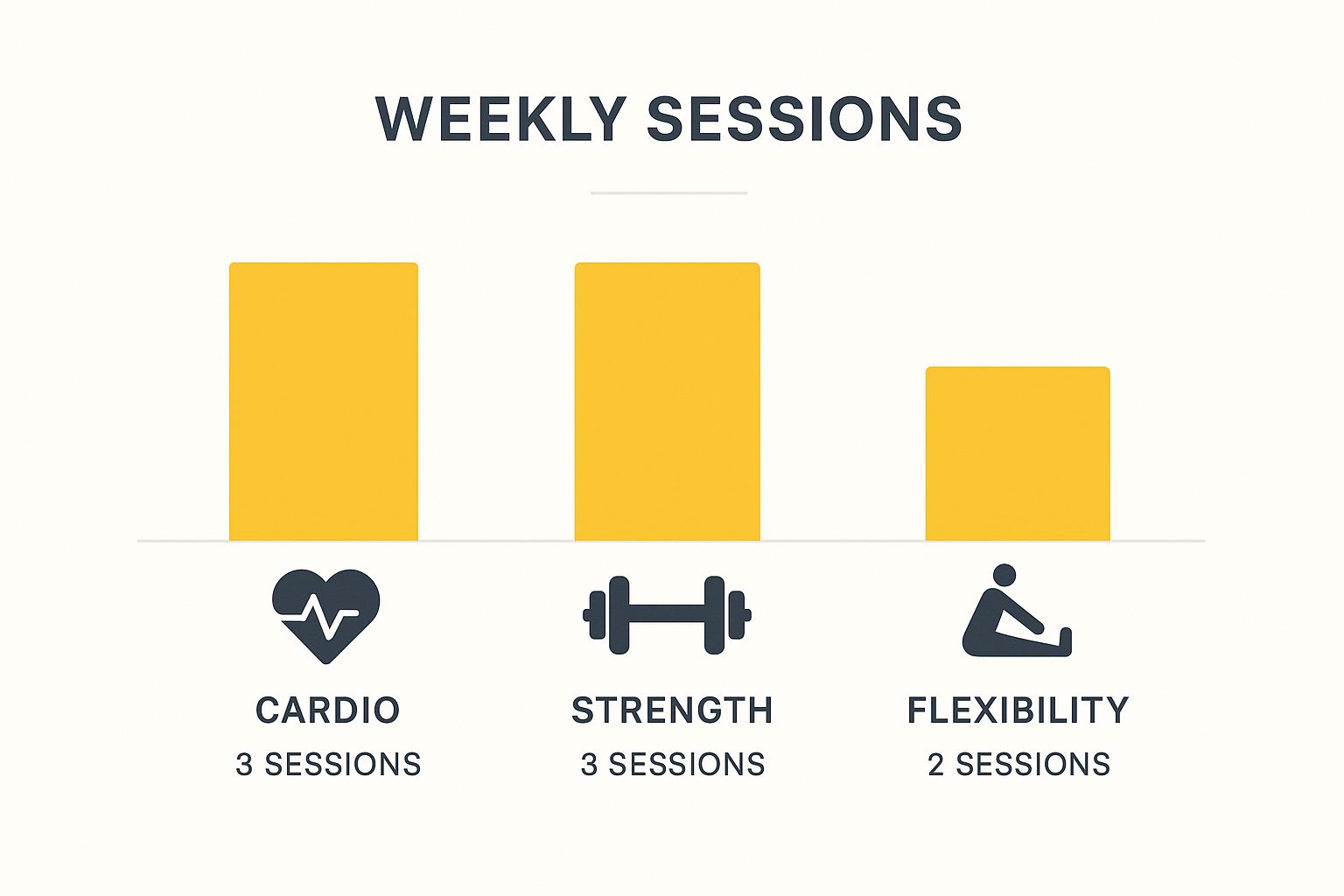Create a Workout Plan: Easy Steps to Achieve Your Fitness Goals
Setting Powerful Fitness Goals That Actually Stick

Before creating a workout plan, it’s essential to define your fitness goals. These goals will guide your training and keep you focused. This means more than just wanting a “better body.” It means setting SMART goals. SMART stands for Specific, Measurable, Achievable, Relevant, and Time-Bound.
Defining SMART Fitness Goals
Instead of saying “I want to get fit,” a SMART goal would be “I want to lose 10 pounds of fat in 12 weeks by exercising three times a week and reducing my daily calorie intake.” This goal is specific (10 pounds of fat loss), measurable (track your weight), achievable (10 pounds in 12 weeks is realistic), relevant (if weight loss is your priority), and time-bound (12 weeks). By stating how you’ll achieve this, you’re creating an action plan for success.
This allows you to create a personalized workout plan. If your goal is to increase muscle mass, your plan might focus on strength training with heavier weights and fewer repetitions. If you want to improve cardiovascular health, your plan might include more endurance activities like running, cycling, or swimming.
Assessing Your Current Fitness Level
After establishing your SMART goals, honestly assess your current fitness level. This means objectively evaluating your strengths and weaknesses. It’s like taking inventory before starting a project.
This self-assessment might involve measuring your resting heart rate, how many push-ups you can do, or how long you can hold a plank. It also helps identify limitations, such as previous injuries. This information is crucial for tailoring your workout plan.
Understanding your limitations allows you to choose appropriate modifications and avoid exercises that could worsen existing problems. This ensures your plan is both challenging and sustainable. This sets the foundation for a successful fitness journey. In the UK, personal training plays a significant role in workout planning. The market size for personal training was projected to surpass £800 million by 2025, reflecting the increasing demand for personalized fitness coaching. Find more detailed statistics here .
Maintaining Motivation and Momentum
Finally, remember that motivation changes. It’s normal to have days when you’re less enthusiastic about exercising. Having clear goals and a structured workout plan can help you overcome these motivational dips. Think of your plan as a roadmap. Even if you feel lost or discouraged, having a clear path can make a difference. Developing strategies to handle these inevitable dips is essential for long-term success.
Measuring Your Fitness Reality (Without Judgment)
Creating a workout plan that truly delivers results begins with honestly assessing your current fitness level. This isn’t about self-criticism, but rather about gathering objective data to build a plan that perfectly suits your individual needs. Think of it as taking inventory of your kitchen before heading to the grocery store – you need to know what you have to work with! This knowledge will help you create a workout plan that is both effective and safe.
Assessing Your Cardiovascular Fitness
Cardiovascular health is fundamental to any good workout plan. A simple step test can help gauge your current aerobic capacity. Find a sturdy box or step about 12 inches high and step up and down at a steady pace for three minutes. Be sure to monitor your heart rate during the test. How quickly your heart rate returns to normal after the test is a key indicator of your cardiovascular fitness and provides a useful baseline for tracking progress.
Evaluating Your Strength
Next, it’s time to evaluate your strength. Bodyweight exercises are perfect for this. How many push-ups can you do with proper form? How long can you hold a plank? These exercises aren’t just random tests; they reveal your muscular endurance and core strength, both crucial for any effective workout plan. Don’t forget to assess your leg strength, too, by checking how many bodyweight squats you can complete with good form. Write down these numbers; they’ll serve as valuable benchmarks as you progress.
Gauging Your Flexibility
Flexibility is often underestimated, but it’s vital for injury prevention and improved performance. A simple sit-and-reach test can assess your hamstring and lower back flexibility. Sit with your legs extended and reach forward as far as you can comfortably go. Evaluating your shoulder mobility – how easily you can raise your arms overhead – is also important, especially for exercises like overhead presses.
Considering Body Composition
While not strictly necessary, understanding your body composition – the ratio of fat to lean mass – can be beneficial. At-home scales that measure body fat percentage can provide a rough estimate. For more accurate measurements, consult a fitness professional who may use techniques like caliper measurements or bioelectrical impedance analysis. This information can help you refine your nutrition plan in conjunction with your workout plan.
Documenting Your Baseline
Finally, record all your measurements. This takes the guesswork out of creating a workout plan, providing solid data to build upon. As you progress, compare your current performance to your baseline. Watching your numbers improve is motivating and confirms that your workout plan is working. Remember, the goal is progress, not perfection. By acknowledging your starting point, you’re setting yourself up for success with a workout plan tailored to you.
Designing Your Perfect Workout Schedule Blueprint
Now that you’ve established your fitness goals and understand your current fitness level, it’s time to build the framework for your workout plan. This involves selecting a workout split, which is simply a structured way to organize your training sessions throughout the week. A well-designed split promotes balanced muscle development and allows for adequate recovery. There are several proven workout splits available, ranging from full-body routines to more specialized approaches.
Understanding Different Workout Splits
-
Full-Body: This split engages all major muscle groups in each session. It’s a great option for beginners and those with limited time for training.
-
Upper/Lower: This split divides your workouts into upper body and lower body sessions, allowing for a more concentrated approach to training specific muscle groups.
-
Push/Pull/Legs: This split categorizes exercises by movement patterns: push (chest, shoulders, triceps), pull (back, biceps), and legs. This allows you to target muscles based on their function.
-
Bro Split: This is a more advanced split typically used by serious bodybuilders, focusing on one muscle group per day. This method requires a significant time commitment in the gym. You might be interested in: How to master a personalized training program .
Choosing the right split depends on several factors: your goals, available training time, and your body’s ability to recover. If your goal is general fitness and you can only train twice a week, a full-body split is ideal. However, if muscle growth is your primary goal and you have more time available, an upper/lower or push/pull/legs split might be more effective.
When designing a workout plan, it’s also helpful to be aware of current fitness trends. For instance, the UK fitness industry is seeing a growing trend towards digital-physical integration. About 3 in 5 UK clubs now offer a combination of in-person and digital workouts. This suggests that successful workout plans should incorporate both physical training sessions and digital resources to enhance engagement. Furthermore, shorter, more efficient workouts are gaining popularity, with 20–30 minute sessions proving effective for member retention. This indicates that workout plans should also consider incorporating shorter, high-intensity sessions to accommodate busy lifestyles. Discover more insights about UK fitness trends .
Creating a Balanced Weekly Schedule

The infographic above provides a visual example of a balanced workout schedule, showing the recommended weekly sessions for cardio, strength training, and flexibility. This balanced approach ensures you’re addressing all key components of fitness, promoting overall well-being and minimizing the risk of injury. Incorporating flexibility exercises twice a week can improve your range of motion and aid in recovery.
Building a sustainable workout routine also requires considering your personal schedule and lifestyle. Start by choosing a realistic number of training days per week. Anywhere from 2-6 sessions is common. Then, schedule your workouts at consistent times that fit your daily routine, just like scheduling any other important appointment. This consistency helps establish a solid workout habit and increases your chances of sticking to the plan long-term.
To help you visualize different workout split options, we’ve compiled a comparison table:
Weekly Workout Split Options Comparison of different workout schedule structures based on time availability and fitness goals
| Split Type | Days Per Week | Ideal For | Recovery Considerations | Example Schedule |
|---|---|---|---|---|
| Full-Body | 2-3 | Beginners, limited time | Full rest days between sessions | Mon: Full Body, Wed: Full Body, Fri: Full Body |
| Upper/Lower | 4 | Intermediate, muscle growth | Alternate upper and lower body to allow recovery | Mon: Upper, Tue: Lower, Thurs: Upper, Fri: Lower |
| Push/Pull/Legs | 3-6 | Intermediate/Advanced, strength & hypertrophy | Rest or active recovery between sessions | Mon: Push, Tue: Pull, Wed: Legs, Thurs: Rest, Fri: Push, Sat: Pull, Sun: Legs |
| Bro Split | 5-7 | Advanced, bodybuilding | Focus on one muscle group allows ample rest for others | Mon: Chest, Tue: Back, Wed: Legs, Thurs: Shoulders, Fri: Arms, Sat & Sun: Rest |
This table provides a quick overview of how different workout splits can be incorporated into your weekly schedule. Remember to select the option that best aligns with your personal fitness goals and time constraints.
Adapting Your Schedule
Flexibility is crucial for long-term success with any workout plan. Life throws curveballs, and unexpected events can disrupt even the most carefully planned schedules. Therefore, it’s important to incorporate flexibility into your plan from the beginning. This means that if you miss a workout, you don’t give up on your plan entirely. Instead, simply reschedule it for another day or make necessary adjustments. This built-in flexibility helps you avoid the common trap of striving for perfection and then abandoning your plan altogether when you fall short. Remember, consistency is the key, but it doesn’t have to be perfect.
Selecting Exercises That Deliver Real Results

The exercises you choose are the cornerstone of any effective workout plan. Instead of focusing on isolating individual muscles, consider training based on fundamental movement patterns. These patterns—push, pull, hinge, squat, carry, and rotate—build balanced, functional strength that translates to everyday activities. This approach ensures you’re not just building muscle, but also preparing your body for real-world movements.
Understanding Movement Patterns
Think of these movement patterns as the basic building blocks of how we move. The squat pattern, for instance, mimics the simple act of sitting down and standing back up. We do this countless times each day. The hinge pattern, exemplified by the deadlift, replicates bending down to pick something up. By training these foundational patterns, you develop a strong base for all other movements.
Choosing Exercises For Each Pattern
A range of exercises exists within each movement pattern, from beginner-friendly modifications to challenging advanced variations. This allows for progressive overload as you get stronger. For example, within the push pattern, you might begin with an incline push-up and progress to a standard push-up, then a decline push-up. For the pull pattern, you could start with inverted rows and work towards pull-ups.
To illustrate the variety of exercises available for each movement pattern, let’s look at the following table. It provides examples for each pattern across beginner, intermediate, and advanced levels.
Essential Exercises by Movement Pattern
| Movement Pattern | Beginner Option | Intermediate Option | Advanced Option | Primary Benefits |
|---|---|---|---|---|
| Push | Incline Push-Up | Standard Push-Up | Decline Push-Up | Chest, Shoulders, Triceps Strength |
| Pull | Inverted Row | Assisted Pull-Up | Pull-Up | Back, Biceps Strength |
| Hinge | Romanian Deadlift (RDL) | Kettlebell Swing | Conventional Deadlift | Posterior Chain Strength, Explosive Power |
| Squat | Bodyweight Squat | Goblet Squat | Barbell Back Squat | Leg Strength, Core Stability |
| Carry | Farmer’s Walk (light weight) | Farmer’s Walk (heavy weight) | Suitcase Carry | Grip Strength, Core Stability, Shoulder Stability |
| Rotate | Russian Twist | Cable Woodchop | Medicine Ball Throw | Core Strength, Rotational Power |
This table highlights the range of options within each movement category, catering to individuals of all fitness levels. When designing your workout plan, aim to incorporate exercises from each pattern for well-rounded strength development.
Adapting Exercises
It’s important to remember that individual needs vary. Pre-existing injuries or limitations might require modifications. If you have a knee injury, for example, you might adapt the squat pattern by doing box squats or wall sits. This lets you build strength safely within your body’s current capabilities. Consulting with a fitness professional is always recommended when unsure about exercise modifications.
Compound Vs. Isolation Exercises
Compound exercises, like squats and deadlifts, work multiple muscle groups at once, making them generally more efficient for building overall strength. Isolation exercises, like bicep curls or triceps extensions, target a single muscle group. While compound movements form the foundation of a good program, isolation exercises can be valuable for addressing muscle imbalances or strengthening lagging body parts. They can supplement your compound lifts to promote balanced muscle development.
By selecting exercises based on these principles, your workout plan becomes a powerful tool for physical transformation and improved athleticism. This approach sets the stage for achieving real, sustainable results – improving not only your physique but also your overall fitness and well-being. This solid foundation allows you to create a workout plan that supports your long-term health and fitness goals.
Mastering the Science of Sets, Reps, and Rest Periods
Understanding the interplay of sets, reps, and rest periods is crucial for creating an effective workout plan. These variables influence how your body adapts to training, determining whether you primarily build strength, increase muscle size (hypertrophy), or enhance endurance. By manipulating these factors, you can fine-tune your workouts to precisely match your fitness goals.
For instance, lower reps with heavier weight generally favor strength gains, while higher reps with lighter weight are typically better suited for muscle growth and endurance.
Decoding Repetition Ranges
Different repetition ranges trigger distinct physiological adaptations. For strength development, aim for 1-5 reps per set. This range forces your nervous system to recruit more muscle fibers, increasing strength without necessarily increasing muscle size. You’re essentially training your body to exert maximum force.
For muscle growth, the sweet spot is typically 6-12 reps. This range induces muscle damage and metabolic stress, both crucial for hypertrophy.
If endurance is your goal, target 15+ reps. Higher reps improve your muscles’ capacity to sustain activity over prolonged periods, enhancing their efficiency and fatigue resistance.
The Power of Progressive Overload
Regardless of your rep range, the principle of progressive overload is paramount. Progressive overload involves systematically increasing the demands placed on your musculoskeletal system.
This could involve increasing the weight you lift, performing more reps with the same weight, or shortening your rest periods. Check out our guide on How to master progressive overload .
Implementing progressive overload stimulates continuous adaptation and prevents plateaus, ensuring consistent progress. However, it’s vital to approach progressive overload gradually to avoid injury or burnout.
The Importance of Rest Intervals
Rest periods play a surprising role in your workout outcomes. For power development, longer rest periods (3-5 minutes) are necessary to allow for full recovery between sets, ensuring you can exert maximal force on each subsequent set.
For metabolic conditioning, shorter rest intervals (30-60 seconds) are more effective. Shorter rest periods create metabolic stress, leading to improved cardiovascular fitness and calorie burning. Your body works harder to recover while still performing the exercise.
Creating a workout plan is increasingly important as the fitness industry grows. In 2023, the UK health and fitness market generated £5,224 million, showing an 8.8% growth from the previous year. Member penetration also rose to 16.0%, highlighting the increasing demand for structured fitness programs. Learn more about the UK fitness industry.
Fine-Tuning Your Workout
Other factors, like lifting tempo (the speed at which you perform each rep), training to failure (performing reps until you can no longer maintain proper form), and time under tension (the duration your muscles are under strain), can also influence your results.
Experimenting with these variables allows you to personalize your workout plan further. By understanding these principles, you can create a workout plan that maximizes your potential for progress and ensures you get the most out of every session.
Building Heart Health Into Your Workout Plan

Cardio, short for cardiovascular training, is essential for any well-rounded workout plan. It strengthens your heart, improves lung capacity, and increases overall endurance. These benefits enhance all areas of fitness, from strength training to daily activities. Strategically incorporating cardio into your plan can dramatically improve your results.
Exploring Different Cardio Methods
Various cardio types offer unique advantages. Steady-state training (SST), like a long jog or bike ride, involves maintaining a consistent, moderate intensity over time. SST builds an aerobic base and improves fat-burning efficiency.
High-intensity interval training (HIIT) alternates short bursts of intense exercise with quick recovery periods. HIIT boosts metabolism and cardiovascular fitness efficiently. Moderate-intensity continuous training (MICT) offers a balanced approach, challenging enough to improve fitness while minimizing overtraining risk.
Balancing Cardio With Strength Training
Combining cardio and strength training effectively is a common question. Many elite coaches suggest prioritizing strength training and strategically adding cardio to minimize the interference effect, where too much cardio can hinder strength gains.
Performing cardio on different days or doing shorter cardio sessions after strength workouts can help balance both aspects of your fitness.
Practical Cardio Workout Options
Effective cardio doesn’t require expensive equipment. Bodyweight circuits, brisk walking, jogging, and cycling are all readily available. How to master your training zones might offer helpful insights for your training. Even simple exercises like jumping jacks or skipping rope can be challenging at-home options. These accessible choices make it easier to create a plan that fits your lifestyle.
Scheduling and Adjusting Your Cardio
Timing matters when scheduling cardio. Same-day cardio can be convenient, but adjust intensity and duration to avoid fatigue. Separate-day cardio allows for more focused sessions and better strength training recovery.
Listen to your body and adjust your cardio based on your recovery and training phase. During intense strength training, reducing cardio volume or intensity may be beneficial. As you progress, gradually increase duration or intensity to avoid plateaus.
Evolving Your Workout Plan for Continuous Progress
Creating a workout plan is the first step. The real key to success is adapting and evolving that plan to ensure continuous progress. This goes beyond simply tracking your weight. Focus on more meaningful metrics that truly reflect improvement. This data-driven approach, favored by successful fitness coaches globally, allows for precise adjustments, keeping your training challenging and effective.
Tracking Your Fitness Journey
Tracking your progress provides crucial insights into your plan’s effectiveness. Methods range from simple pen-and-paper logs to sophisticated fitness apps like Fitbit . Record key metrics like weight lifted, reps performed, resting heart rate, and how you feel after each workout. This data reveals patterns and highlights areas ripe for improvement. You might be interested in: How to master a hybrid training program .
Identifying and Breaking Through Plateaus
Plateaus, where progress stalls, are a natural part of the fitness journey. It’s important to distinguish between true plateaus and normal performance fluctuations. If you’ve consistently tracked your workouts and notice stagnation for several weeks, it’s likely time to adjust your plan. Evidence-based strategies for breaking through plateaus include:
-
Manipulating Program Variables: Change your sets, reps, rest periods, or the exercises themselves. For example, if you’ve been doing 3 sets of 10 reps, try increasing the weight and reducing the reps to 3 sets of 8. This forces your body to adapt.
-
Introducing New Exercises: Adding new exercises challenges your muscles in different ways, helping overcome plateaus and target lagging muscle groups. This can be as simple as switching from barbell squats to dumbbell lunges.
Systematic Program Adjustments
Adjusting your workout plan should be systematic, based on objective feedback, not emotional reactions or fleeting fads. Small changes, like adding a set or slightly increasing the weight, can make a big difference. Sometimes, a complete program overhaul is necessary. This could involve switching from a full-body routine to an upper/lower split or changing your training focus entirely.
Maintaining Motivation and Celebrating Milestones
Tracking visible progress is inherently motivating. Seeing tangible improvements keeps you engaged and reinforces your commitment. Celebrating milestones, whether it’s a new personal best or completing a challenging workout, fuels long-term adherence. These small victories boost morale and solidify your dedication.
Start your personalized fitness journey today with Kracey, a dynamic training platform creating custom Hyrox training plans tailored to your race date, fitness level, and available equipment. Discover your inner champion with Kracey .
Table of Contents
- Setting Powerful Fitness Goals That Actually Stick
- Defining SMART Fitness Goals
- Assessing Your Current Fitness Level
- Maintaining Motivation and Momentum
- Measuring Your Fitness Reality (Without Judgment)
- Assessing Your Cardiovascular Fitness
- Evaluating Your Strength
- Gauging Your Flexibility
- Considering Body Composition
- Documenting Your Baseline
- Designing Your Perfect Workout Schedule Blueprint
- Understanding Different Workout Splits
- Creating a Balanced Weekly Schedule
- Adapting Your Schedule
- Selecting Exercises That Deliver Real Results
- Understanding Movement Patterns
- Choosing Exercises For Each Pattern
- Essential Exercises by Movement Pattern
- Adapting Exercises
- Compound Vs. Isolation Exercises
- Mastering the Science of Sets, Reps, and Rest Periods
- Decoding Repetition Ranges
- The Power of Progressive Overload
- The Importance of Rest Intervals
- Fine-Tuning Your Workout
- Building Heart Health Into Your Workout Plan
- Exploring Different Cardio Methods
- Balancing Cardio With Strength Training
- Practical Cardio Workout Options
- Scheduling and Adjusting Your Cardio
- Evolving Your Workout Plan for Continuous Progress
- Tracking Your Fitness Journey
- Identifying and Breaking Through Plateaus
- Systematic Program Adjustments
- Maintaining Motivation and Celebrating Milestones